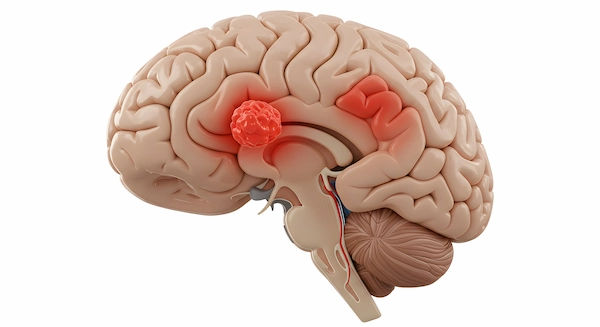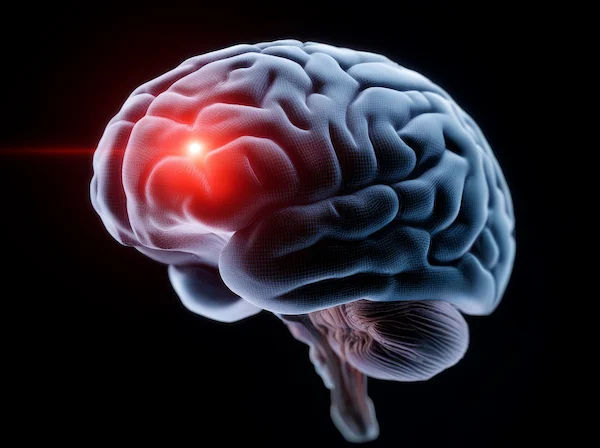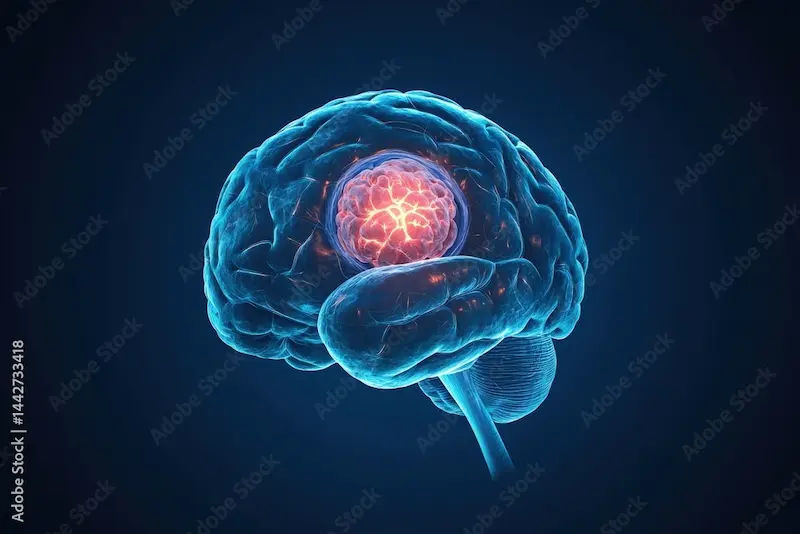Understanding Brain Tumours: A Comprehensive Guide to Symptoms, Types, and Treatment
Know about the brain tumours, what it is, types based on origin, common types of tumours, diagnosis, treatment options and more.


Introduction
Finding out about a brain tumour, whether for yourself or a loved one, can be an overwhelming experience filled with complex medical terms and uncertainty. The brain is the command centre of our body, and any abnormality within it naturally raises serious concerns. This guide is designed to demystify brain tumours, providing you with clear, compassionate, and comprehensive information. We will walk you through everything from the fundamental basics of what a brain tumour actually is to the different types, the symptoms you should not ignore, and the modern diagnostic and treatment options available today. Our goal is to empower you with knowledge, helping you understand the condition, ask the right questions, and navigate the path forward with greater confidence. Remember, while this information is valuable, it is not a substitute for professional medical advice.
What is a Brain Tumour? The Basics Explained
At its core, a brain tumour is an abnormal mass of tissue in which cells grow and multiply uncontrollably. The skull, which protects the brain, is a rigid structure. Any extra growth inside this confined space can create pressure on the brain, leading to a range of health problems. It's crucial to understand that not all brain tumours are cancerous. The distinction between different kinds of growths is the first step in understanding the diagnosis and potential outcomes.
Consult a Top Oncologist for Personalised Advice
Benign vs. Malignant Brain Tumours: What's the Difference?
This is one of the most critical distinctions.
Benign Brain Tumours: These are non-cancerous growths. They typically grow slowly, have clear borders, and do not spread to other parts of the body. However, "benign" does not mean "harmless." Because they are located in the sensitive environment of the skull, even a slow-growing benign tumour can cause significant problems by pressing on critical areas of the brain, leading to serious symptoms and requiring treatment.
Malignant Brain Tumours: These are cancerous. They contain cancer cells that grow rapidly, often invading and destroying nearby healthy brain tissue. They can also spread to other parts of the central nervous system. Their aggressive nature makes them particularly dangerous.
Primary vs. Metastatic: Where the Tumour Begins
Another key classification is the tumour's origin.
Primary Brain Tumours: These tumours originate in the brain itself. They develop from brain cells, the membranes surrounding the brain (meninges), nerve cells, or glands. The types of primary brain tumours—like gliomas or meningiomas—are named for the type of cell they arise from.
Metastatic (Secondary) Brain Tumours: These are more common. These brain tumours begin as cancer in another part of the body—such as the lung, breast, or skin (melanoma)—and then spread (metastasise) to the brain. Their characteristics are based on the original cancer, not brain tissue.
Common Types of Brain Tumours
There are over 120 different types of brain tumours. Understanding the specific type is essential for determining treatment and prognosis. Here are some of the most common ones.
Gliomas (e.g., Glioblastoma, Astrocytoma)
Gliomas are the most common type of primary brain tumour, accounting for about one-third of all cases. They develop from glial cells, which are the supportive cells in the brain. Gliomas are typically malignant and are graded on a scale from I (least aggressive) to IV (most aggressive).
Glioblastoma (GBM): A Grade IV glioma, this is one of the most aggressive and common malignant brain tumours in adults. It grows quickly and can be difficult to treat.
Astrocytoma: These tumours arise from astrocytes, a type of glial cell. They can be low-grade (I or II) or high-grade (III or IV, with GBM being a grade IV astrocytoma).
Meningiomas: Often Benign but Problematic
Meningiomas are tumours that arise from the meninges, the layers of tissue that cover the brain and spinal cord. They are the most common primary brain tumours, and about 90% are benign (Grade I). They grow slowly, but because they can become quite large, they can press on the brain, causing significant symptoms. Treatment often involves monitoring or surgery.
Other Notable Types
Pituitary Adenomas: These are benign tumours that develop on the pituitary gland at the base of the brain. They can cause symptoms by producing excess hormones or by pressing on the optic nerves, affecting vision.
Schwannomas (e.g., Acoustic Neuroma): These are typically benign tumours that develop on the nerves responsible for balance and hearing. They are known for causing symptoms like hearing loss and tinnitus.
Recognizing the Signs: Symptoms of a Brain Tumor
The symptoms of a brain tumour are incredibly varied and depend on the tumour’s size, location, and rate of growth. They can be subtle at first and are often mistaken for more common conditions.
General Symptoms Caused by Pressure
As a tumour grows, it increases pressure inside the skull (intracranial pressure). This can cause:
Headaches: Often worse in the morning or when lying down, and may worsen over time or with activity.
Nausea or Vomiting: Especially unexplained nausea that may occur in the morning.
Seizures: A sudden, uncontrolled electrical disturbance in the brain. A new-onset seizure in an dult is a significant red flag.
Vision Problems: Blurred vision, double vision, or loss of peripheral vision.
Cognitive Changes: Memory problems, confusion, or personality changes.
Location-Specific Symptoms: What Part of the Brain is Affected?
Frontal Lobe: Changes in personality, judgment, and reasoning; weakness on one side of the body.
Temporal Lobe: Difficulty with speech, memory, and understanding language; seizures.
Parietal Lobe: Problems with sensory perception, reading, and hand-eye coordination.
Occipital Lobe: Vision loss in one or both eyes.
Cerebellum: Loss of coordination, balance problems, dizziness.
If you or someone you know is experiencing persistent or worsening neurological symptoms like these, it is crucial to consult a doctor. You can book an appointment with a specialist neurologist online through Apollo24|7 for an initial consultation.
How are Brain Tumours Diagnosed?
If a brain tumour is suspected, the diagnostic process begins with a thorough neurological exam to test vision, hearing, balance, coordination, and reflexes. The cornerstone of diagnosis, however, is imaging.
The Role of Neurological Exams and Imaging (MRI, CT)
Magnetic Resonance Imaging (MRI): This is the most common and detailed imaging test for brain tumours. It uses powerful magnets and radio waves to create cross-sectional images of the brain. A special dye (contrast agent) is often used to make tumours more visible.
Computed Tomography (CT) Scan: A CT scan uses X-rays to create detailed images. It is often used in emergencies to quickly check for bleeding or a large mass.
The Biopsy: Confirming the Diagnosis and Grade
While imaging can show a mass, a biopsy is often needed for a definitive diagnosis. During a biopsy, a small sample of tissue is removed from the tumour, typically during surgery. A neuropathologist then examines the cells under a microscope to determine the type and grade of the tumour. This information is vital for planning the most effective treatment for the brain tumour.
Modern Treatment Options for Brain Tumours
Treatment is highly personalised and depends on the tumour’s type, size, location, and grade, as well as the patient’s overall health. A multidisciplinary team of neurosurgeons, neuro-oncologists, and radiation oncologists typically works together to create a plan.
Brain Tumour Surgery: The Goal of Removal
Whenever possible, surgery is the first-line treatment. The primary goal is to remove as much of the tumour as possible without damaging surrounding healthy brain tissue. Techniques like awake brain surgery and advanced imaging guidance allow surgeons to operate with remarkable precision.
Radiation Therapy: Targeting Cancer Cells
Radiation therapy uses high-energy beams, such as X-rays or protons, to kill tumour cells. It is often used after surgery to eliminate any remaining cancer cells or for inoperable tumors. Advanced techniques like stereotactic radiosurgery (e.g., Gamma Knife) can deliver highly focused beams to a small area, minimising damage to healthy tissue.
Chemotherapy and Targeted Drug Therapies
Chemotherapy: Uses powerful drugs to kill fast-growing cancer cells. It can be given orally or intravenously. For brain tumours, a wafer impregnated with chemotherapy drugs can sometimes be placed in the brain during surgery.
Targeted Therapy: These drugs focus on specific abnormalities present within cancer cells. By blocking these abnormalities, targeted drug treatments can cause cancer cells to die. They often have different side effects than chemotherapy.
Life After Diagnosis: Prognosis and Living with a Brain Tumour
A brain tumour diagnosis is a life-changing event. Prognosis varies widely. For some with a benign, removable tumour, the outlook can be excellent. For others with a high-grade malignant tumour, the journey is more challenging.
Factors That Influence Prognosis
Key factors include the tumour type, grade, location, how much can be surgically removed, the patient's age, and overall health. It's important to have open and honest conversations with your healthcare team about your specific situation.
Conclusion
Navigating the world of brain tumours is complex, but knowledge is a powerful tool. Understanding the differences between tumour types, recognising the potential warning signs, and being aware of the advanced treatment options available can help reduce anxiety and foster productive conversations with healthcare providers. The field of neuro-oncology is constantly evolving, with new research leading to more effective and targeted therapies every year. While a diagnosis is daunting, there is always hope and a path forward focused on treatment, management, and quality of life. If you have any concerns about symptoms you are experiencing, the most important step is to seek professional medical guidance promptly. If your condition requires diagnostic imaging or lab tests, Apollo24|7 offers convenient home collection services and can help coordinate next steps with specialist care.
Consult a Top Oncologist for Personalised Advice
Consult a Top Oncologist for Personalised Advice

Dr. Sanchayan Mandal
Medical Oncologist
17 Years • MBBS, DrNB( MEDICAL ONCOLOGY), DNB (RADIOTHERAPY),ECMO. PDCR. ASCO
Kolkata
MCR SUPER SPECIALITY POLY CLINIC & PATHOLOGY, Kolkata

Dr. Sanchayan Mandal
Medical Oncologist
17 Years • MBBS, DNB Raditherapy, DrNB Medical Oncology
East Midnapore
VIVEKANANDA SEBA SADAN, East Midnapore

Dr.sanchayan Mandal
Medical Oncologist
17 Years • MBBS, DrNB( MEDICAL ONCOLOGY), DNB (RADIOTHERAPY),ECMO. PDCR. ASCO
Kolkata
Dr. Sanchayan Mandal Oncology Clinic, Kolkata

Dr. Rupam Manna
Radiation Specialist Oncologist
4 Years • MBBS MD(RADIO THERAPY)
Barasat
Diab-Eat-Ease, Barasat

Dr Gowshikk Rajkumar
Oncologist
10 Years • MBBS, DMRT, DNB in Radiation oncology
Bengaluru
Apollo Clinic, JP nagar, Bengaluru
More articles from Brain Tumor
Frequently Asked Questions
1. What are the first signs of a brain tumour?
The earliest signs can be subtle and vary, but common red flags include new, persistent headaches that are different from past headaches, unexplained nausea or vomiting (especially in the morning), new-onset seizures, and gradual changes in vision, hearing, or speech.
2. Can a benign brain tumour be fatal?
Yes, although they are non-cancerous, a benign brain tumour can be life-threatening if it grows in a critical location where it presses on vital brain structures, causing increased intracranial pressure or impairing essential functions.
3. What is the survival rate for a malignant brain tumour?
Survival rates for malignant brain tumours like glioblastoma vary significantly based on the tumour grade, the patient's age, and other health factors. It's a highly individual statistic that your oncologist can discuss based on your specific diagnosis.
4. Are there any known causes of brain tumours?
For most brain tumours, the exact cause is unknown. The only well-established environmental risk factor is exposure to high doses of ionising radiation. A small percentage of tumours are linked to inherited genetic syndromes.
5. What is the latest treatment for brain cancer?
Research is ongoing. Current advanced treatments include tumour-treating fields (TTF), which use electrical fields to disrupt cancer cell division, immunotherapy to harness the body's immune system, and new targeted therapies based on the genetic profile of an individual's tumour.




